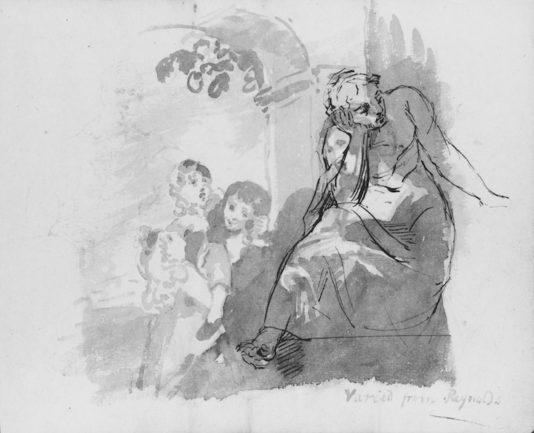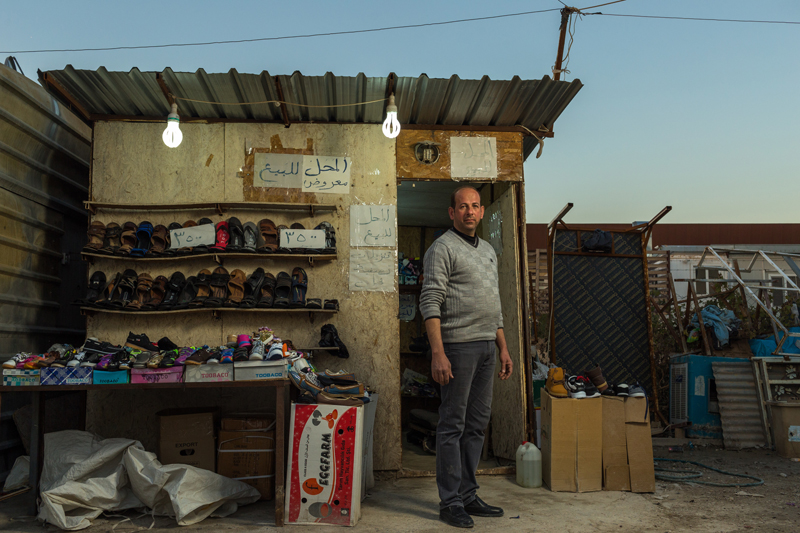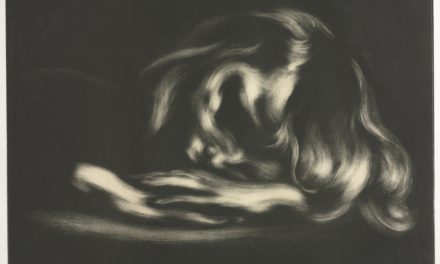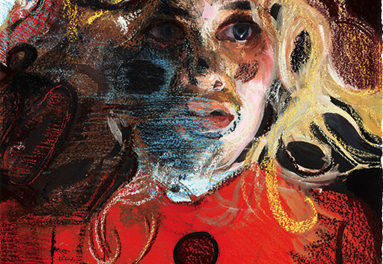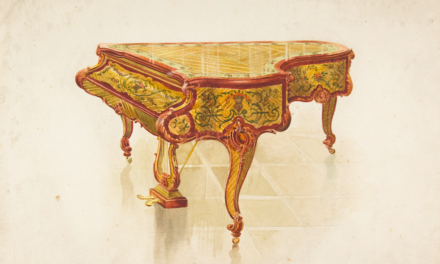Sully, Thomas. After Reynolds; Mother and Three Children; Draped Figure Studies (from Sketchbook). 1810-1820, The Metropolitan Museum of Art, New York.
Even Though
by Ann E. Wallace
I sucked in my breath as my friend sprinted past me on the forest trail to ask the woman ahead of us, “Mom, did something happen to your knees?” “Mmmhmm.” A murmured affirmative, followed by a silence that warned him not to push further.
That the woman’s grown son had never noticed her misshapen knees puzzled me that day, and continues to do so. Indeed, my friend might never have noticed had their swollen outline not caught my eye as we walked several paces behind her on a hike. I wondered aloud to him—though quietly, as if intuitively aware that the question itself were verboten—what had happened to his mother, a woman I had never met before, and I felt oddly anxious when he shrugged his shoulders innocently and bolted up the path to ask.
She wore her scars outwardly, yet, when my friend learned their history a few weeks later, I realized his mother’s past had gone unnoticed for decades. Don’t psychologists say that in our constant state of distraction, we fail to notice much of what is right before us? Indeed, as children, the narrowness of our focus keeps us from seeing our mothers as women with stories of their own.
When my children were five and eight, I moved them into the bookcase-lined room that had been my study. Their belongings filled the lower shelves, while I kept my books up high: Virginia Woolf sat above Brown Bear, Brown Bear; Beloved directly over Madeline and Amelia Bedelia. Midway up, I left, amid a miscellany of knickknacks that had no other home, a small square framed photograph of myself at age twenty-two. It had been taken in the summer, though you wouldn’t know that, as I was wearing a pumpkin mohair cardigan, standing in front of a small still life I had painted in college, a Frida Kahlo calendar, and a vase filled with fragrant dried eucalyptus branches. I remember the moment clearly.
I was waiting for my new home healthcare nurses to arrive at my apartment when the photograph was taken. Barely an hour later, the warmth captured in the image had evaporated. I lay flat on my back, a bare arm extended, while one of the nurses punctured the skin and threaded a twenty-inch length of IV tubing up my vein. Blood flowed, puddling under my arm as she methodically pushed the tube further and further up the vein from my elbow toward my chest.
A nearly imperceptible pinprick scar still marks the site where she installed the peripherally inserted central catheter (PICC) into the crook of my left elbow that afternoon. But none of this is visible in the photo taken before the nurses arrived. You would not know the memories the snapshot marks, for I am the only one who remembers the blood, the spaghetti tubing, the IV line poking from my arm for five months after.
The photo marks the moment before I was plunged into a world of disease alien and unfamiliar: the PICC line, the nurses in their gloves and gowns, the bandages and needles filled with heparin, the sharps container placed in my bathroom. But that was just the beginning. Every fourth Sunday for months after, the inside of my refrigerator was stocked by special delivery with pouches of chemotherapy: vincristine, anthramycin, cytoxan. From Monday to Friday the contents were slowly emptied into me by my nurses wearing medical hazmat suits and rubber gloves so thick that “you could scrub your toilet with these,” as one commented. My apartment was re-mapped by cancer.
What is most immediately striking about the photograph, which remained on the bookshelf when I moved my children into their new bedroom twenty years after it was taken, however, is that I am completely bald. My twenty-two-year-old pale-skinned face, with waning but still defined eyebrows and smooth head, gazed out at my girls every day. And I can only imagine that they gazed back at me.
I wonder what they saw, what they thought, how long it took before they realized it was me, and whether the me in the photograph was recognizable to them in the fuller sense as the me that I am now. Today, at ages eleven and fourteen, they know that I had cancer before they were born. If asked, they might even say ovarian cancer, perhaps even remark that it was a very deadly form of cancer. No, that part is not likely. How could they know the fact of the danger from the other end, from the way-after point when they entered my story?
I am not sure how my illnesses past or present figure in their imaginations, but I know that cancer is one of the diseases they know about me. I may have left the photo on the shelf so that would be true. It was not spoken, but neither was it secret, hidden, hushed up. Unlike the woman with the shattered knees, this is not a story that they are discouraged from exploring. Or is it? Is the silent weight of the photograph enough to keep further questions at bay?
The photograph was far from my mind when Abby, my youngest, came home last March and declared, “Mom, I want to interview you for school.” I was flattered, imagining that she wanted to ask about my role in founding her school for Women’s History Month. I was wrong: “Mom, I picked you because you became a teacher and have done all of these things even though you had cancer.”
I was puzzled by what “even though” meant for her in that sentence. Is it similar to the idea of persevering and overcoming that adults hold in their imaginations about cancer survivors? I think it is close. But there’s something in those words uttered by my child born years after one of my ovaries was removed, born because one and only one ovary was removed, that rests on the idea that cancer had the potential to shape everything in my life after it. Did the photo on the shelf stage that premise for her? Had I left it there for her to think of everything else as “after cancer”?
Abby’s framing was right. But not entirely. Cancer set my life on a particular course. But it was never an “even though”; it has always been a “because.” Cancer catapulted me into full adulthood in my early twenties, and I set and achieved large goals for myself because of it. Facing illness, pain, even death gave me boldness and focus.
I took the girls skiing for the first time two years ago. I had not been on skis in twenty years, but I felt exhilarated, breezing through the snow. My older daughter Molly did not enjoy skiing, but Abby fell in love. On a late afternoon run, I watched as she went gliding down the slope, exclaiming, “I feel so light. I feel like I’m floating. I’m floating, Mom!” I skied alongside her to capture the magic on my iPhone. I have the photos and videos, but my memory of her smile, her arms outstretched as she floated along, is alive without them. The photos are for her, in case she ever needs to be reminded what it felt like to glide down a mountain for the first time.
The photos are honest and real, but they are incomplete. The story beyond the photos is not a secret, but it is one I hope that Abby does not remember, or does not connect to the beauty of the day. It is the story of “even though.” But it is not about cancer. I took my girls skiing, even though I now have multiple sclerosis and knew that the physical toll on me would be, was, severe, even if temporary. I fought against exhaustion on the drive home, repeatedly missing turns, the trip extending late into the evening. The next morning, my world shifted off balance as vertigo, surprisingly at bay on the slopes, took root and settled in for the day. I rested and silently raged against multiple sclerosis. But a few days later, Abby and I got in the car and drove off to the mountain again.
Even though.
I do not keep the fact or the reality of my MS hidden. Like with cancer, my refrigerator is once again full of medicine, syringes full of Copaxone now instead of bags of chemotherapy. The girls know I fight to slow the constant spin in my head and that fatigue deep within my bones can set in in an instant. Or do they? What does vertigo mean to an eleven-year-old? I have no idea.
They can imagine but cannot know what vertigo means for me. It is invisible. And normal. Abby was two when I was diagnosed, so how would she separate her understanding of her mother’s disease from her idea of her mother? There is no “before MS” for Abby.
My friend’s mother broke her knees when the son was a toddler, perhaps the same age Abby was when I was diagnosed with MS. My friend had woken wailing in the middle of the night, rousing his father who found his wife collapsed on the kitchen floor, the life draining out of her. She was rushed to the emergency room. The child’s cry had saved the mother’s life. This was the story, of a mother-son lifeline, told to the son on his eighteenth birthday.
But as with most stories, there is more. She was on the kitchen floor in a puddle, her wrists bleeding. At the hospital, doctors determined that she had had a rare suicidal reaction to a medication, and while she was weaned off of the drug, she was kept restrained in her hospital bed. The staff who bound her to the bed, however, underestimated the strength of the drug still brewing within her. She broke free, jumped out a window, and her knees and bandaged wrists taking the impact of the fall.
When the son questioned his mother twenty-odd years later about the disfigured knees he had never before noticed, she did not answer him, not completely. She was upset that her son had asked, that he had not known intuitively the story that he had never been told. His father, again, filled in the blanks of his wife’s silence, more fully this time. My friend, the compliant son, knows not to speak of any of it—the bleeding wrists, the hospital restraints, the broken bones—to his mother. My own knowledge an accident, I am intrigued that a mother’s past signaled so clearly on her body remained unquestioned and unspoken for decades. Shame stains the story, shaping it into a secret whispered in darkness, not meant to be shared beyond those who know.
Shame is a powerful force, transferred from mother to child in the silence it has carved out of a family’s story. I like to think that I reject the notion of shame within my own trajectory of illness, but that is not entirely true. Even so, cancer and MS hold silences that defy pride and survival. I cannot see my world through my children’s eyes, and, while I want their sightlines to remain unobstructed, I do not want them to see it through mine.
During a recent home renovation, I took my photograph out of my children’s room and placed it on my own bookshelf. They have gazed at it long enough and it has told them the most important thing: I had cancer but I was vibrant and alive, even though. That is not the complete story, but it is true. And if their attention is caught on the feat of having survived cancer decades ago, perhaps that will pull their attention away from the even though or the what next of my MS. As a mother, I have little control over the world my daughters see, but, for as long as I can, I am content to watch them float in the beautiful present of right now.
Ann E. Wallace lives in Jersey City, NJ with her daughters, who keep her eager for new—and not so new—adventures, even though it might be easier to stay home and read a good book instead. She writes poetry and nonfiction about illness, loss, family, and other everyday realities. Her work has recently appeared in Intima, Juniper, The Literary Nest, Eunoia Review, Rogue Agent, and Raising her Voice: An Anthology of Women Writers, among other places. She can be found on Twitter @annwlace409.

